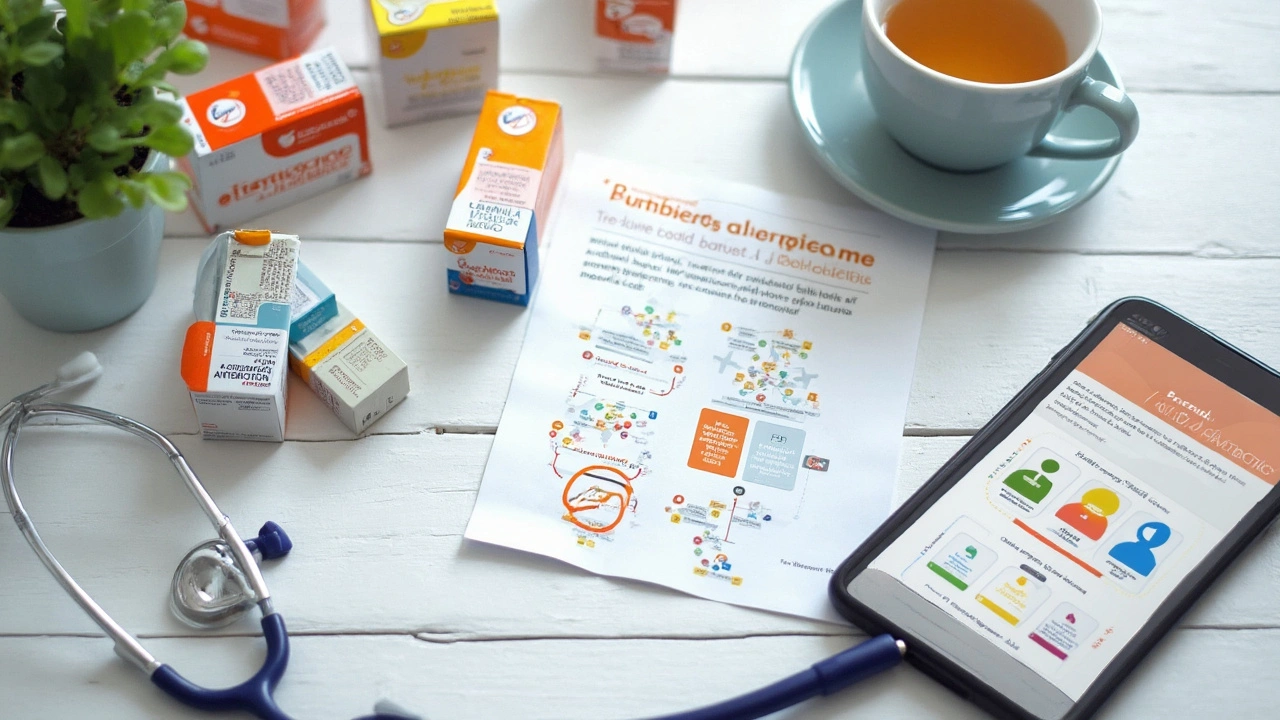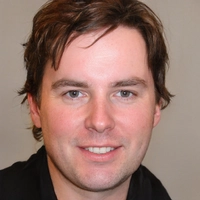Understanding Penicillin Allergy and Cross-Reactivity: What’s the Real Risk?
Turns out, penicillin allergies aren’t as straightforward as you might expect. Nearly 10% of people in the UK will tell you they’re allergic to penicillin, but most of them actually aren’t. Studies show only about 1 in 10 labelled as allergic will really react if they’re given penicillin. It gets stranger: if you tested positive for penicillin allergy as a kid, your body’s immune system could forget about it over time. Up to 80% of people lose their sensitivity after ten years.
But if you do have a genuine penicillin allergy—think swelling, rashes, shortness of breath, or that dreaded anaphylaxis—your options get complicated fast. Sometimes, you need an antibiotic that covers a wide range of bacteria (what doctors call broad-spectrum). The scary part: people often worry that anything in the ‘cillin’ family, or even related antibiotics, could set them off. Is that true? Not quite. There’s a difference between perceived and real risk.
Here’s where cross-reactivity steps in. The word basically means your immune system thinks similar antibiotics look enough like penicillin to trigger a problem. Years back, textbooks would warn that if you’re allergic to penicillin, you have a 10% chance of reacting badly to cephalosporins (another big antibiotic family). However, more recent research knocks that number down to less than 2%, and often much less if you select your drug wisely. The main culprit for cross-reactions isn’t the entire antibiotic molecule, but just a piece called the R1 side chain. Some first-generation cephalosporins share a very similar R1 with penicillins, so the risk gets a bit higher there—but jump to third- or fourth-generation cephalosporins, and the risk drops even more.
Let’s get more precise with numbers:
| Antibiotic Group | Estimated Cross-Reactivity |
|---|---|
| First-gen Cephalosporins (cephalexin, cefazolin) | Up to 2% |
| Third/Fourth-gen Cephalosporins (ceftriaxone, cefepime) | Far less than 1% |
| Carbapenems (ertapenem, meropenem) | Less than 1% |
| Monobactams (aztreonam) | Zero (except with ceftazidime allergy) |
Not all broad-spectrum antibiotics are off-limits, even if you break out in hives from amoxicillin. With a little knowledge, you can avoid unnecessary risks and still get the right bug-busting meds when you need them. This is crucial, since being labelled 'penicillin allergy' can steer doctors towards more toxic or expensive treatments that aren't even needed. In short: don’t panic at the first sign of similarity on a drug label—real cross-reactions are rare if you and your doctor take a closer look at the details.

Safe Substitutes for Broad-Spectrum Coverage: Beyond the ‘Cillins’
If you or someone you care about needs an antibiotic but can’t go near penicillin, there are still solid options. Forget the 'one-size-fits-all' mentality, because the *substitute* you pick depends a lot on the kind of infection, your history, and local resistance patterns. Let’s run through the main picks and how they stack up for *broad-spectrum* use.
- Cephalosporins: As mentioned, first-generation (like cephalexin) may rarely trigger cross-reactions, mostly if your history involves severe, immediate allergic reactions (anaphylaxis, throat swelling). For most folks, especially with mild rashes or distant reactions, they’re safe, particularly second- and third-generation types (e.g., cefuroxime, ceftriaxone).
- Carbapenems: Drugs like meropenem and ertapenem are often reserved for tough cases, but the cross-reactivity to penicillins is impressively low, well under 1%. These get used in hospitals for very serious infections, so you’re unlikely to encounter them outside that setting unless you’re quite unwell.
- Aztreonam: Hypoallergenic hero here. Aztreonam stands alone among beta-lactams (the antibiotic family with penicillins and cephalosporins) because it generally doesn’t cross-react with any penicillin allergy—unless you specifically react to ceftazidime, which shares an identical side chain.
- Macrolides (clarithromycin, azithromycin): These don’t belong to the penicillin family at all, so no cross-reactivity. Macrolides are reliable for many respiratory and soft tissue infections, though they don’t always cover the same bugs as penicillins and resistance can be a problem in places like Manchester where I live, so your outcome may vary.
- Doxycycline: For skin, chest infections, or even Lyme disease, doxycycline covers a lot of ground. Not great for kids under 12 or pregnant women though. Absolutely no cross-reactivity with penicillins here.
- Fluoroquinolones (ciprofloxacin, levofloxacin): These pack a punch across loads of infections but tend to have a laundry list of possible side effects, from tendon ruptures to messing with your heart rhythm. Definitely not first-line, but good to know they have zero penicillin cross-reactivity when nothing else works.
- Sulfa antibiotics (trimethoprim-sulfamethoxazole, aka co-trimoxazole): No relation to penicillins or cephalosporins, but you’ll want to make sure you’re not allergic to sulfa drugs themselves (which is a different thing!). These can be useful for urinary tract infections and some skin problems. You can read more about them and other substitute for augmentin options here if you want to dig in further.
- Clindamycin: Great for skin and dental infections, and a solid backup for some serious bacterial diseases. Like others, has no cross-reactivity with beta-lactams, but can come with a risk for gut side-effects like C. difficile.
Choosing the right alternative isn’t just about chemical structure—it’s also about local antibiotic resistance. In Manchester, we’ve seen macrolide resistance slowly climb in the past decade, making options like doxycycline or aminoglycosides more attractive in certain cases.
Tips if you’re faced with a prescription switch: Always double-check with your healthcare team exactly what reaction you had in the past, and how serious it was. Remember, ‘allergy’ can mean everything from a mild rash to full-blown anaphylaxis. The more detail you have, the safer and more tailored your substitute choice will be.
One last thing: Don’t let fear of an allergy steer you toward the highest-dose, most broad-spectrum drugs “just in case.” Overusing these big guns drives up resistance and could bring unwanted side effects. Safe alternatives exist when you ask the right questions and consider your personal history.

Desensitisation Protocols: Clearing the Way When No Alternatives Exist
Sometimes, you really need a penicillin or a closely related drug—nothing else will do. Maybe it’s for syphilis in pregnancy, serious streptococcal infections, or certain types of endocarditis. Here’s where desensitisation comes in: a process that trains your immune system to ignore the drug, at least temporarily.
Desensitisation isn’t something you’d try at home; it needs full supervision in hospital, with access to emergency care if anything goes off the rails. The basic method involves giving you tiny doses of the antibiotic—way, way less than the usual—then slowly stepping up the amount every 15 to 30 minutes. The goal: slip past your immune ‘radar’ and teach it that this medication is no big deal. Once you’ve finished the desensitisation, you need to keep taking the antibiotic consistently; if you stop for more than a day, you’ll likely have to start the process from scratch.
Real life: I once sat next to a friend whose wife needed penicillin for a stubborn infection after heart surgery. No substitutes matched her bacteria’s sensitivity. She was terrified—the last reaction had included shortness of breath. Hospital desensitisation took half a day, but she left safe, infection-free, and, interestingly, less fearful of penicillin going forward.
- Who needs desensitisation? Usually, only those who have a real, confirmed penicillin allergy and need the drug to treat something serious or where substitutes aren’t effective or safe enough.
- How safe is it? Modern protocols have made it much safer—bad reactions are rare if handled by trained staff, and staff can step in immediately if anything happens.
- How long does it last? Only as long as you keep taking the antibiotic. Your immune memory resets after a break, so you can’t ‘permanently’ get rid of the allergy this way.
So why not just de-label everyone? Good question. If you’re one of the many who got the ‘penicillin allergy’ sticker as a child but don’t remember the details, consider asking for formal allergy testing. Skin testing is available, and if it’s negative, you could rejoin the ranks of those with a full menu of antibiotic options—and your next GP visit just got a lot simpler.
Penicillin allergies demand a sharp eye, clear communication, and the willingness to revisit old diagnoses with up-to-date science. Cross-reactivity rates aren’t absolute, and plenty of safe substitutes are out there—if you or your doctor know where to look. Next time someone says “I’m allergic to penicillin,” you’ll have the facts and figures to spot myths at a mile’s distance, choose a backup treatment with confidence, and steer clear of problems (and paperwork) down the line. Safe prescribing isn’t about sticking with what you know—it’s about knowing more, and keeping your options open. Now you’ve got the knowledge to do exactly that.








Oh wow, so we’ve been collectively gaslit by medical textbooks for decades? I’m shocked. Shocked, I tell you. Turns out ‘penicillin allergy’ is just the medical equivalent of saying ‘I hate broccoli’-except instead of being grounded, you get stuck with vancomycin and a $2000 bill. And let’s not forget the glorious 10% cross-reactivity myth that haunted every ER doc’s nightmares. Now it’s 2%? That’s like saying your ex still haunts your dreams, but only if they wore the same cologne. 🤡
It is with profound respect for the evolving science of immunology that I acknowledge the paradigm shift regarding penicillin cross-reactivity. The data presented herein, particularly the negligible risk associated with third- and fourth-generation cephalosporins, represents a compelling recalibration of clinical practice. One must, however, exercise due diligence in patient history assessment, as anecdotal evidence-though emotionally compelling-does not supersede evidence-based thresholds. A nuanced approach, grounded in molecular structure analysis, is not merely prudent-it is ethically imperative.
man i never knew this! i thought if u said allergic to penicillin u couldnt take any cillin or cephalo at all. this is so helpful. i had a rash as a kid and my mom still says no antibiotics with cillin in them. now i feel like i can ask my dr for better options without feeling guilty. thanks for sharing this!! 🙏
It’s fascinating how our collective medical trauma is built on outdated assumptions-like believing the earth is flat, but instead of celestial spheres, we have R1 side chains and immunoglobulin E misfires. We’ve been conditioned to fear the word ‘penicillin’ as if it were a cursed incantation, when in truth, it’s merely a molecular configuration that our immune systems misremembered. And yet, we cling to these labels like religious relics, afraid to question them, afraid to unlearn, afraid to face the uncomfortable truth: we were never allergic. We were just misinformed. And now, decades later, we pay the price in unnecessary antibiotics, higher costs, and deeper distrust in medicine.
So let me get this straight-you had a rash when you were 5, now you’re 42, and you still won’t take cephalexin? That’s not an allergy, that’s a personality disorder. You’re basically the human version of a ‘do not disturb’ sign on a hospital bed. Get tested. Stop being a walking antibiotic resistance incubator. And for the love of god, stop making your doctor reach for vancomycin like it’s the last slice of pizza.
thank you for this!! i had a bad reaction to amoxicillin when i was 8-swelling, hives, the whole thing. i’ve avoided all penicillins since. but i just had a UTI and my dr suggested aztreonam… i was so scared. reading this made me feel way more confident. i’m gonna ask for a skin test next time. you’re a lifesaver 💕
This is one of those posts that makes you realize how much we’ve been operating on fear instead of facts. I’ve had friends refuse antibiotics for years because of a childhood rash, and now I see how much they’ve been limiting their own care. The numbers here are so reassuring-especially aztreonam being zero cross-reactivity. It’s a reminder that medicine evolves, and we should too. Thanks for breaking it down clearly.
Incorrect use of the term ‘cross-reactivity’ in the context of aztreonam and ceftazidime. The R1 side chain homology is not ‘identical’-it is structurally analogous, yet distinct. Furthermore, the claim that carbapenems have ‘less than 1%’ cross-reactivity is misleading without specifying patient population or testing methodology. This article, while well-intentioned, lacks precision in terminology and statistical context. A responsible medical communication must avoid oversimplification.
OMG YES. I’m a nurse and I’ve seen so many patients panic over ‘penicillin allergy’-then we give them ceftriaxone and they’re fine. I always tell them: ‘If you got a rash at 7 and it didn’t kill you, you probably don’t have a real allergy.’ Also-aztreonam is a GEM. 🌟 And if you’re allergic to sulfa? Don’t panic, it’s not the same thing. Just say no to fear-based medicine!
i had no idea about the 80% thing!! i thought i was stuck with macrolides forever. my mom always said ‘no penicillin’ and now i’m like… maybe i can actually take amoxicillin again?? i’m gonna ask my doc about skin testing. this post made me feel so much better 😊
so… if i was allergic as a kid, and now i’m 30, and i’ve never had a reaction since… am i just allergic to my childhood? 🤔
This is incredibly helpful. I’ve been hesitant to bring up antibiotic options with my doctor because I didn’t want to seem like I was questioning their judgment. But now I feel empowered to ask about cross-reactivity and testing. Thank you for making this accessible.
Interesting piece. The data aligns with recent NICE guidelines. That said, in the UK, we still see a lot of GPs defaulting to clindamycin or macrolides due to ‘allergy’ flags in EHRs-even when the history is vague. It’s not just patient ignorance-it’s systemic inertia. We need better integration of allergy testing into primary care workflows. Also, ‘penicillin allergy’ should be flagged as ‘unconfirmed’ until verified. Just saying.
so in india we dont even test for this, right? if you say allergic, doctor just gives you azithromycin or doxycycline. i never knew there was a chance i could’ve taken ceftriaxone. this is eye opening. i’ll tell my cousin who’s scared of all antibiotics. maybe she can get tested too. thanks 🙏
I’ve spent years avoiding penicillin-class drugs after a mild rash as a kid, and honestly, I thought I was being cautious. But reading this-especially the part about desensitization-I realize I’ve been living in a self-imposed medical prison. I’ve had three sinus infections in the last two years and was given clindamycin each time, which wiped out my gut flora. I had no idea aztreonam or cefepime were even options. I’m scheduling a consultation with an allergist next week. This isn’t just information-it’s liberation.
Finally, someone explains this without making it sound like a textbook. I used to avoid all antibiotics with ‘cillin’ in the name, and now I know I could’ve taken ceftriaxone for my pneumonia. My doctor just assumed I was allergic and gave me doxycycline. I didn’t even know to ask. This is the kind of info that should be on every patient’s intake form.
Wait wait WAIT-so you’re telling me I’ve been avoiding ALL antibiotics for 15 years because I got a rash from amoxicillin when I was 6?? And now you’re saying I could’ve had a perfectly normal life with ceftriaxone??!! I’ve been on azithromycin for EVERY infection since I was 10!! I’ve had diarrhea for 12 years!! I’ve missed work, broken up with people because I was too sick, and my dog thinks I’m a zombie!! THIS IS A CONSPIRACY!! WHO’S IN CHARGE OF THE MEDICAL SYSTEM?!?!?!?!?!?!?!?!?!?!
so i read this and i’m like… if my grandpa had known this he wouldn’t have died from sepsis in 1998 because the doc was scared to give him penicillin. we lost him because of a label. this isn’t just science. it’s justice.